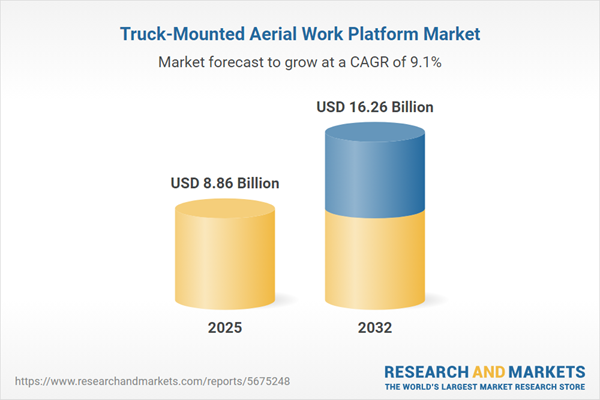Speak directly to the analyst to clarify any post sales queries you may have.
The truck-mounted aerial work platform market is undergoing rapid transformation as technological innovation, evolving regulations, and regional infrastructure investments drive demand across a spectrum of industries. Senior executives evaluating this sector can expect disruptive trends, shifting supply chains, and digital advancements that inform critical procurement and strategic decisions.
Market Snapshot: Truck-Mounted Aerial Work Platform Market
The truck-mounted aerial work platform market grew from USD 8.12 billion in 2024 to USD 8.86 billion in 2025 and is projected to achieve a compound annual growth rate (CAGR) of 9.06%, reaching USD 16.26 billion by 2032. Market momentum is reinforced by infrastructure modernization, stringent safety regulations, and the uptake of digital solutions. Growth remains robust across construction, utilities, and infrastructure segments, with notable expansion in both established and emerging economies.
Scope & Segmentation
- Type: Articulating Boom (Up To 20 M, 20 To 30 M, Above 30 M); Telescopic Boom (Up To 20 M, 20 To 30 M, Above 30 M)
- End User: Construction; Infrastructure Maintenance; Utilities
- Height Range: Up To 20 M; 20 To 30 M; Above 30 M
- Platform Capacity: Up To 200 Kg; 201 To 300 Kg; Above 300 Kg
- Mobility Class: Light Duty; Heavy Duty
- Power Source: Diesel; Electric
- Geographic Coverage: Americas (United States, Canada, Mexico, Brazil, Argentina, Chile, Colombia, Peru); Europe, Middle East & Africa (United Kingdom, Germany, France, Russia, Italy, Spain, Netherlands, Sweden, Poland, Switzerland, United Arab Emirates, Saudi Arabia, Qatar, Turkey, Israel, South Africa, Nigeria, Egypt, Kenya); Asia-Pacific (China, India, Japan, Australia, South Korea, Indonesia, Thailand, Malaysia, Singapore, Taiwan)
- Company Coverage: Terex Corporation; Palfinger AG; Oshkosh Corporation; Manitex International, Inc.; Altec Industries, Inc.; Ruthmann GmbH; Oil & Steel S.p.A.; Niftylift Ltd.; CTE S.p.A.; DPL Group, Inc.
Inclusion of cutting-edge articulating and telescopic platforms, capacity variants, and diverse powertrains enables targeted solutions for unique job site requirements. Market segmentation by geography addresses nuanced regional regulatory goals and procurement trends.
Key Takeaways for Senior Decision-Makers
- Digitalization, including IoT integration and real-time telematics, is redefining fleet management, enabling predictive maintenance and increased equipment uptime.
- Automation advancements such as semi-autonomous leveling and remote operation are streamlining job site safety and improving operator productivity.
- The market is experiencing a pivot toward electrification and hybrid drivetrains, aligning product offerings with sustainability mandates and emerging emissions standards.
- Regional go-to-market strategies are now essential as countries within North America, Asia-Pacific, EMEA, and Latin America display distinct adoption patterns for power sources and platform types.
- Business models are adapting, with service and maintenance agreements being bundled into equipment offerings, creating recurring revenue and stronger client relationships.
- Market consolidation through mergers and acquisitions is accelerating, while joint ventures foster localized production and facilitate compliance with local content requirements.
Tariff Impact: Navigating Regulatory Shifts
Recently imposed United States tariffs on imported components have complicated the global supply chain, prompting manufacturers to reassess procurement models and increase localization of assembly. To counteract margin pressures, stakeholders are diversifying sourcing strategies, exploring manufacturing hubs outside traditional areas, and renegotiating supplier agreements. Meanwhile, service and pricing structures are evolving to lessen end-user impact while protecting profitability across the value chain.
Methodology & Data Sources
This market analysis integrates quantitative data with qualitative insights from executive interviews, field surveys, industry reports, and regulatory filings. Cross-referenced data triangulation and advanced statistical modeling support the accuracy and reliability of segment trends, regional distribution, and performance benchmarks.
Why This Report Matters
- Enables strategic investment and procurement planning by offering granular segmentation and actionable insights.
- Helps navigate evolving trade and regulatory environments—including tariffs—by mapping supply chain risks and regional opportunities.
- Supports product development and go-to-market decisions with in-depth coverage of technology adoption and regional differentiation in end-user demand.
Conclusion
The truck-mounted aerial work platform market continues to evolve, shaped by digital, regulatory, and regional forces. This report provides senior leaders with the intelligence required to drive growth, streamline operations, and maximize competitive advantage as industry dynamics accelerate change.
Additional Product Information:
- Purchase of this report includes 1 year online access with quarterly updates.
- This report can be updated on request. Please contact our Customer Experience team using the Ask a Question widget on our website.
Table of Contents
3. Executive Summary
4. Market Overview
7. Cumulative Impact of Artificial Intelligence 2025
Companies Mentioned
The companies profiled in this Truck-Mounted Aerial Work Platform market report include:- Terex Corporation
- Palfinger AG
- Oshkosh Corporation
- Manitex International, Inc.
- Altec Industries, Inc.
- Ruthmann GmbH
- Oil & Steel S.p.A.
- Niftylift Ltd.
- CTE S.p.A.
- DPL Group, Inc.
Table Information
| Report Attribute | Details |
|---|---|
| No. of Pages | 184 |
| Published | October 2025 |
| Forecast Period | 2025 - 2032 |
| Estimated Market Value ( USD | $ 8.86 Billion |
| Forecasted Market Value ( USD | $ 16.26 Billion |
| Compound Annual Growth Rate | 9.0% |
| Regions Covered | Global |
| No. of Companies Mentioned | 11 |









